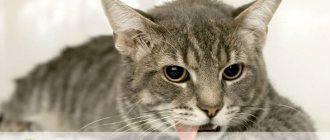If your cat is hiding or running away, it means she is not herself. She is afraid that she may be harmed or that her life is in danger. If your cat's behavior suddenly changes, there is likely a fear-based explanation.
If your cat is suddenly scared, consider whether anything has recently changed in her environment. Disruptions to the cat's daily routine can make a cat skittish, such as moving furniture and new people. Your cat may have encountered a predator near her home and no longer feels safe. Unexpected loud noises (thunder, construction and screaming) as well as illness and injury make cats feel vulnerable.
It takes a calm, relaxed owner to cope with the needs of a frightened cat. In fact, the owner's anxiety will make the cat even more nervous. You need to calm your cat, but how you approach this depends on the reason.
Why did the cat suddenly get scared?
Cats love to project confidence and fearlessness, but they don't always feel that way on the inside. Cats are good at hiding their fear and trepidation because they don't like people knowing that they are afraid or vulnerable.
If your cat gets hurt, you may not know it. Cats do everything they can to hide signs of injury. Your cat is worried that the injury is seen as weakness. This can cause the cat to lose territory or dominance status.
© shutterstock
It's the same with illness. Cats hide their pain, but they are frightened by feeling unwell. For example, according to Hormones and Behavior, parasitic infections (roundworms, tapeworms, heartworms, hookworms, and whipworms) are a concern because cats don't know what's wrong.
Cat abuse is a broad definition. Your cat may have been physically injured many years ago. Unfortunately, certain smells and places can trigger memories of this traumatic event in the past.
Scolding a cat for unwanted behavior leads to anxious behavior. Anxiety and fearfulness are more likely when punishment occurs after an action because cats do not associate scolding with behavior problems. Your cat will become nervous, wondering if she will be punished again.
What symptoms should you be wary of?
A sign of some kind of illness in an animal may be dryness and increased temperature of the nose.
If a cat hides under the sofa, begins to behave strangely, and meows for no apparent reason, this indicates that the pet is sick. You should immediately take her to a veterinarian if the following signs are observed:
- The cat doesn't eat and hardly drinks.
- Frequent vomiting or diarrhea appears.
- The pet became very thin and lethargic.
- There is difficulty breathing, the mouth is slightly open.
- Long-term obsessive states.
- An increase in temperature, as indicated by a hot, dry nose.
- Difficulty urinating.
- Refusal of food, water, play.
- The cat constantly sits in a dark place and does not come out for more than 1 day.
What makes cats afraid?
Cats have many fears and phobias based on their instincts. Most of them are rational, but not all. Common things that cats are afraid of include:
- Loud noises
- Changes in daily routine or schedule
- Unfamiliar people or pets in the house
- Wide open spaces
- Predatory animals
- Visit to the veterinarian
- Separation from owner
Any of these problems can make your cat scared. Anxiety takes its toll on cats. According to applied animal behavior science, stressed cats live with persistently elevated cortisol levels. Cortisol is colloquially referred to as the “stress hormone.” This explains why your cat is afraid.
Dogs. Main enemy?
Cats are afraid of dogs. This statement is partly true. For cats, a dog is an incomprehensible creature that is always trying to disturb its peace. The dog, seeing the cat for the first time, runs towards it and tries to get to know it. At the same time, he wags his tail and barks loudly. In this way, the dog shows friendliness and tries to play with her. But for a cat, such behavior is hostile. After all, a cat waves its tail and makes sounds only in case of aggression. Therefore, she rushes to attack the friendly dog in order to get ahead of the enemy. The second time the dog meets the cat, he will be much more careful and, perhaps, will try to attack first.
How to help your cat cope with change
Cats are creatures of habit, so changes in their structure and routine are a major concern. If your cat doesn't feel safe, she will become increasingly afraid. The most significant changes a cat can undergo are:
- New habitat
- New pet
- New Person/Baby Arrival
A cat will notice if its owner is away longer than usual. In the same way, cats experience bereavement if a person or companion animal dies.
© shutterstock
Live in a new house
For cats, moving home is difficult because everything they know has changed. This means that the cat needs to learn everything all over again.
Here the cat's fear of outer space comes to the fore. Until you unpack your things, the house will be empty. Your cat has lost all its favorite hiding places. He needs to explore the new landscape of the earth, and he will be very afraid until this happens.
Focus on providing your cat with shelter. Every time you unpack a box, leave it on its side. Place these boxes around your new home and your cat will feel safer.
Unpack familiar items for your cat. Furniture that smells like your cat will have a calming effect. Make sure your cat has familiar toys and trees.
Stick to your cat's previous routine and give her plenty of one-on-one attention. Feed your cat when she expects to be fed.
Adaptation to a new pet
Having a new pet can be very upsetting for your cat. Cats are territorial by nature, and the idea of sharing a home with a potential rival can cause anxiety. In addition, a new animal may intimidate an existing one.
When bringing a new cat into your home, do it slowly. Keep the new cat locked in a room until your existing pet accepts him. Introduce two cats through a gate so they recognize each other's scents.
Feed cats in different places. Provide each animal with its own food bowls, water bowls, litter trays, toys and bed. Play with your cat and give him one-on-one attention.
Resident of a new house
Cats get used to people living in their house. When a new resident arrives, the cat will be outraged. Infants will be especially horrified.
Babies are noisy and require the attention that cats used to have. Your cat will become vocal and intrusive, fearing that she has been replaced. The cat imitates the behavior of the baby.
Friends and partners can also frighten cats. New people bring new smells, sounds and behaviors. At first the cat will be afraid of this new person.
Once a cat begins to mark a person, a bond can begin. Cats recognize people by voice, not by sight. The more a cat hears a new human voice, the faster it will begin to overcome its fear.
© shutterstock
Noisy environment
Cats have good hearing. Loud sounds, especially short and sharp ones, cause stress in cats, as a result of which cats are afraid. These disturbing background noises include:
- Car horns
- Garbage trucks
- Emergency car sirens
- Fireworks
- Household appliances, such as vacuum cleaners
- Thunder and lightning
- Doorbells
- Street work
Fear of predators
As the Journal of Animal Ecology explains, the animal kingdom is divided into three levels. These are prey, mesopredator and superpredator. Cats are mesopredators. This means that they are hunters and hunted.
Your cat may have encountered a predator in your yard. This will cause significant, lasting fear. Cats are driven by instinct and are always looking for threats.
If your cat is afraid, keep her indoors, especially at night. Over time, your cat will calm down and feel safe again. Until that happens, provide reassurance and a safe environment.
Separation anxiety in cats
If you leave your cat alone for long periods of time, she may develop separation anxiety. When you return, the cat will be afraid and nervous. Your cat is worried that you might leave again.
You will need to regain your cat's trust and show her that you will not give up on her. You may need to help your cat understand that you always come home after a period of absence.
Keep the cat away from you for a short time. When you return, offer your cat food so that she begins to perceive your return as positive. Your cat will not be afraid of your leaving and will look forward to your return.
Article Author: Richard Parker I'm Richard, I have experience in all matters related to feline health, behavior, grooming techniques and general pet care. Richard graduated with a degree in journalism in 2008. He is the proud owner of 5 adult cats (all adopted stray breeds), including an older cat who is now 20 years old.
Helping your cat cope with stress
Cats have a hard time with changing their environment; it is stressful for them. What to do if you can’t avoid a trip to the country, a trip to the veterinarian or hairdresser?
Two necessary conditions for the trouble-free movement of a cat are a calm owner and a comfortable carrier, which should become a second home for the animal. You cannot carry the animal in your arms.
Before traveling, prepare a mobile shelter for your cat - a comfortable carrier with hard walls, soft bedding and ventilation. For sound insulation and warmth, the carrier is wrapped with soft cloth on top. The cat should perceive the mobile house as a shelter where your pet can hide, say, after a doctor’s examination and calm down.
Required conditions after stress - peace and quiet
Habit plays an important role. If you plan to often take your cat with you on trips, you need to gradually accustom it to this from childhood. A pet that regularly travels in its portable home will not create problems during its next voyage.
Medicinal methods
In order to prepare the cat for stress, which cannot be avoided, special medications based on herbal ingredients are used. For example, Fitex contains hops, motherwort, valerian, and Baikal skullcap. In addition to these herbs, Stop-Stress contains phenibut. The drug Kot Bayun is available in the form of infusion and tablets. It includes extracts from a dozen medicinal plants.
To overcome stressful situations, calming cat food containing herbal sedatives and special collars with pheromones are also produced.
A calming collar with pheromones will help the animal cope with a stressful situation
Table: Calming products for cats
| A drug | Active substance | Release forms | Dosage | Effect | Price |
| Stop stress | Active ingredients: phenibut (aminophenylbutyric acid) + extracts of medicinal plants (catmint, motherwort, hops, Baikal skullcap). | Drops and tablets | 1 drop per kg of animal body weight twice a day; or 0.25 tablets with a weight up to 5 kg, 0.5 - with a weight from 5 to 10 kg; for body weight more than 10 kg, give a whole tablet. | Long lasting calming effect | 145 rub. |
| Fitex | Plant origin. The composition of the drug includes the following extracts: - thick extract of valerian officinalis (valeriana officinalis) - dry extract of motherwort (leonurus quinquelobatus gilib) - dry extract of common hop (humulus lupulus) - dry extract of Baikal skullcap (scutellaria baicalensis georgi) 1 ml The drug contains 100 mg of the sum of dry and thick extracts. Does not contain sugar or ethyl alcohol. | Drops | 3–5 drops three times a day | Mild sedation | 130 rub. |
| cat Baiyun | Only plant components, contains aqueous extracts from plant materials: oregano herb - 0.45%, sweet clover herb - 0.23%, rhizomes with valerian roots - 0.23% and phytocomplex - 1.45%, containing extracts of flowers and fruits hawthorn, hop cones, motherwort herb, peppermint leaves, ivy grass, catnip herb, lemon balm herb, meadowsweet flowers, St. John's wort herb, thyme herb, cudweed herb, hillwort herb, nettle leaves, roots, rhizomes and herb of evasive peony , and as an auxiliary substance - distilled water - up to 100%. | Infusion and tablets | A single dose for infusion is 2 ml (half a teaspoon); for tablets - 2 pieces. Frequency of administration: 3–4 times a day. Tablets are used starting from the age of 10 months of the animal. | Long-term sedative effect: stabilization of the animal’s condition for 5–7 days | Drops - 132 rub. per package. Tablets - 115 rub. |
| Xylazine | The synthetic compound is a derivative of thiazine Xyl as an active ingredient in 1 ml contains 20 mg of xylazine hydrochloride, as well as excipients: sodium metabisulfite - 1 mg, citric acid - 10 mg, benzyl alcohol - 0.01 ml, sodium hydroxide (for pH correction = 5.0) and water for injection - up to 1 ml. | Injection | According to the instructions for use, 0.25 ml per 100 kg of weight is used for sedation; for sedation accompanied by muscle hypotonicity and analgesic effect - 0.5 ml; for immobilization and pain relief 1.0 ml; for long-term surgical intervention 1.5 ml (this dose is used only for adult animals). | Calming, analgesic, muscle relaxant | 630 rub. |
Photo gallery: sedative medications
Fitex drops for cats calm and heal Xylazine has a calming and analgesic effect Drops for cats Stop Stress have a long-lasting calming effect Kot Bayun - a dietary supplement for a calm life for cats
No one is immune from stress and fear, not even cats. Each domestic cat has a unique character and temperament. No one knows how your pet will behave in an unusual situation. Only love, care and the right reaction will help owners of tailed pets find the right approach to their animal and help them cope with emotional turmoil.
How to recognize fear in a pet
When a cat is afraid, he reacts like this:
- runs away;
- hiding;
- shows aggression;
- freezes in place;
- cries (meows pitifully);
- lick themselves too actively;
- curl up into a ball, pretending to be asleep.
If he doesn't like the smell (eg aerosol/perfume with citrus scent), he may shit in the wrong place, including. into the owner's slippers. Your task is to correctly understand the signals of what the cat is most afraid of, find and eliminate the irritant.
Focus on the game and training
Use interactive play to build your cat's confidence. A fishing rod toy or pointer light allows your cat to have fun with you, but at a distance that is unlikely to cause an attack.
Teaching cats tricks builds confidence and helps strengthen their bond with their humans. You can use clicker training to communicate with your cat and show approval. When a cat's aggression is focused on another cat due to fear, use positive reinforcement techniques to reduce guarding.
A common mistake is to expect that aggression can be eliminated overnight. If you can recognize the cause, it will still take time, practice and consistency to help your cat eliminate the reaction.
Don’t be surprised, relapses will happen, and don’t scold your cat, as this will only make things worse for her. If the aggression cannot be resolved or you are having trouble identifying the trigger, it may be time to seek professional help. A veterinarian or an experienced cat behavior specialist can help.
Fear of light
Perhaps the pet is simply afraid of light. This is the norm if we are talking about a kitten or a pregnant cat.
The cubs are born completely blind. Their eyes are closed because they are not yet formed to meet the light. The pupils, which can dilate or contract, are responsible for the perception of light. The pupils of kittens that have just opened their eyes cannot adjust to the brightness of the light, so you can often notice how babies hide in dark places, and sometimes simply turn their faces away from the lighting fixtures. This phenomenon will pass when the animal grows a little.
Cats that are preparing to become mothers change their behavior: some become more sociable, others diligently avoid human society. But in one thing they are the same: when the birth approaches, they want to build a nest for themselves.
Representatives of some breeds do not do this themselves; they wait for the owner to think of making a nest for them. Usually during this period the cat behaves very restlessly, it meows loudly and leads the owner to the place where it wants to have a home. In this case, it is very important to arrange a cozy bed for the expectant mother, protected from bright light, and to monitor it, because the cat will wait for human help during childbirth.
Those cats that set up a nest on their own expect one thing from the owner: he must guess her intentions and make room for a home. Helping the animal with this is very important, because if this is not done, the furry mother in labor may well choose a shelf in your linen closet for these purposes. To prevent the animal from hiding, you can help him with arranging his home:
- Make a box with one low side and three high ones.
- Cover it with soft materials. You can use old clothes for this.
What to do if the cat hid in a secluded corner?
If a cat is afraid of everything, the provoking factor of fear and stress should be eliminated, since this condition leads to cardiovascular diseases. When a cat hides under a blanket, you need to give him the opportunity to warm up, especially an old pet. A hidden cat should be given comfortable conditions at the sight of guests - taken to another room, placed there with bowls of food and water, and a tray. It is advisable to periodically visit your pet, pet it and talk calmly.
When the reason why a cat is looking for a secluded place is shyness, the owner should not punish the animal, but talk to it kindly, even if the person is upset by the pet’s behavior. When cats hide their kittens, this means that something is bothering the pet, so the owner needs to establish the cause and eliminate it. If animals are sick and hiding, it is necessary to show them to a veterinarian, who will identify the disease and prescribe treatment.











